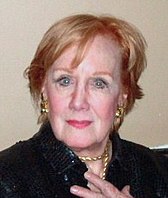Marni Nixon's Human Design Chart
4/6 Sacral Manifesting GeneratorAmerican soprano and ghost singer for featured actresses in musical films, including Deborah Kerr in The King and I (1956), Natalie Wood in West Side Story (1961), and Audrey Hepburn in My Fair Lady (1964). Nixon is recognized for this work today but her roles were uncredited and concealed from audiences when the films were released.
Nixon’s varied career included, besides her voice work in films, some film roles of her own, television, opera, concerts with major symphony orchestras around the world, musicals on stage throughout the United States and recordings.
She dubbed Marilyn Monroe’s high notes in “Diamonds Are a Girl’s Best Friend” in Gentlemen Prefer Blondes (1953). In 1956, she worked closely with Deborah Kerr to supply the star’s singing voice for the film version of Rodgers & Hammerstein’s The King and I, and the next year she again worked with Kerr to dub her voice in An Affair to Remember. In 1961’s West Side Story, the studio kept her work on the film (as the singing voice of Natalie Wood’s Maria) a secret from the actress, and Nixon also dubbed Rita Moreno’s singing in the film’s “Tonight” quintet. She asked the film’s producers for, but did not receive, any direct royalties from her work on the film, but Leonard Bernstein contractually gave her 1/4 of one percent of his personal royalties from it. For My Fair Lady in 1964, she again worked with the female lead of the film, Audrey Hepburn, to perform the songs of Hepburn’s character Eliza. Because of her uncredited dubbing work in these films, Time magazine called her “The Ghostess with the Mostest”.
Nixon made a special guest appearance on Leonard Bernstein’s Young People’s Concerts broadcast that aired on 9 April 1961, entitled Folk Music in the Concert Hall. She sang three “Songs of the Auvergne” by Canteloube. Under her own name, she recorded songs by Jerome Kern, George Gershwin, Arnold Schönberg, Charles Ives, Aaron Copland and Anton Webern. Nixon was nominated for two Grammy Awards for Best Classical Performance, Vocal Soloist, one for her Schönberg album and one for her Copland album.
Nixon’s first onscreen appearance was as Sister Sophia in the 1965 film The Sound of Music.
Nixon taught at the California Institute of Arts from 1969 to 1971 and joined the faculty of the Music Academy of the West, Santa Barbara, in 1980, where she taught for many years. In the late 1970s and early 1980s, she hosted a children’s television show in Seattle on KOMO-TV channel 4 called Boomerang, winning four Emmy Awards as best actress, and made numerous other television appearances on variety shows and as a guest star in prime time series. She also toured with Liberace and Victor Borge and in her own cabaret shows.
In 2000, after nearly a half century away, she returned to Broadway as Aunt Kate in James Joyce’s The Dead. In 2001, Nixon replaced Joan Roberts as Heidi Schiller in the Broadway revival of Stephen Sondheim’s Follies. In 2003, she was again on Broadway as a replacement in role of Guido’s mother in the revival of Nine.
The first of her three husbands, Ernest Gold, composed the theme song to the movie Exodus. They married in 1950 and had three children, including singer-songwriter Andrew Gold (1951-2011). They divorced in 1969. She was married to Dr. Lajos “Fritz” Fenster from 1971 to 1975, and then to woodwind player Albert Block from 1983 until his death in 2015.
Marni Nixon survived breast cancer in 1985 and 2000 but died from the disease on 24 July 2016 in New York, aged 86.
Link to Wikipedia biography
Discover More Famous People
Browse and analyze over 55,000 public figures and celebrities.
Ra Uru Hu
5/1 Manifestor
Martha Stewart
4/6 Manifestor
David Lynch
4/6 Generator
Barack Obama
6/2 Projector
Steve Jobs
6/3 Generator
Vladimir Putin
5/1 Manifestor
Kim Kardashian
3/5 Generator
Michael Jackson
1/3 Projector
Marilyn Monroe
6/2 Projector
Ariana Grande
2/4 Projector
Oprah Winfrey
2/4 Generator
Johnny Depp
2/4 ManifestorWhat is HumanDesign.ai and how does it work?
Curious what makes Marni Nixon tick? HumanDesign.ai instantly maps their exact birth data into a fully interactive clickable bodygraph chart, letting you hover or tap every center, channel, and gate for plain-language explanations. Bella, the platform’s built-in AI guide, adds context in real time, translating complex mechanics into everyday insights so you can see how Marni Nixon’s strengths, challenges, and life themes play out on-screen.
The same tools are waiting for you. Generate your own Human Design Chart in seconds, open a library of 2000+ suggested questions, and chat with Bella as often as you like to decode your design, daily transits, and even relationship dynamics.
Want to compare energies? Save unlimited charts for friends, family, or clients, then ask Bella to reveal compatibilities, composite patterns, or coaching tips, all in one conversation thread.
Start free with core features, or unlock our Personal and Pro plans for deeper dives: unlimited Q&A, celebrity chart search spanning 55,000+ public figures, white-label PDF reports, branded content generation, and a professional profile with built-in booking for practitioners. Whether you’re exploring your own potential or guiding others, HumanDesign.ai delivers an ever-expanding toolbox of AI-powered insights—no spreadsheets, no jargon, just clarity at your fingertips.
Ready to see yours? Signup for FREE today!

